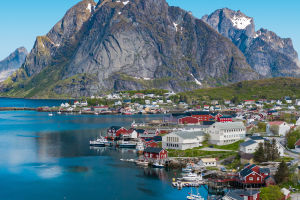Hello, Lykkers! If the call of the wild has ever tugged at your heart, then the Lofoten Islands in Norway should be at the top of your travel list.
This archipelago, with its dramatic peaks, serene fjords, and picturesque fishing villages, is nothing short of a Nordic dream.
Imagine towering mountains plunging into the sea, quaint red cabins dotting the landscape, and the ethereal dance of the Northern Lights illuminating the night sky. Lofoten is a place where nature's beauty is untamed, yet accessible—a paradise for adventure seekers and tranquility lovers alike.
Getting to Lofoten: A Journey Worth the Effort
Reaching Lofoten requires a bit of planning, but the journey is as much a part of the adventure as the destination itself. The nearest airport is in Bodø, which is well-connected to Oslo and other major Norwegian cities. From Bodø, a scenic ferry ride to Moskenes takes about 3 to 4 hours, offering breathtaking views of the coastline and a chance to spot sea eagles soaring above. Alternatively, you can fly directly into Leknes or Svolvær airports on the islands.
For those who prefer a more leisurely pace, the Hurtigruten coastal ferry service provides a beautiful cruise experience along Norway's rugged coast, with a stop in Stamsund in Lofoten. Driving is another option, with the E10 highway linking the islands to the mainland—perfect for a road trip that showcases the stunning landscapes at every turn.
Must-See Spots in Lofoten
Lofoten's charm lies in its diverse natural wonders, from jagged peaks to pristine beaches. Here are some must-visit spots:
Reine: Often described as the most beautiful village in Norway, Reine is the epitome of Lofoten's idyllic charm. Surrounded by steep mountains and crystal-clear waters, it's a photographer's paradise. Hike the Reinebringen trail for a panoramic view of the village—just be prepared for a steep climb! The trail is free to access, but it's best to start early to avoid crowds.
Hauklandstranda: Haukland Beach, with its powdery white sand and turquoise waters, feels almost tropical despite its northern location. This is the perfect spot for a summer swim, a picnic, or simply soaking in the serene atmosphere. The beach is open year-round, and there's no entry fee. In the winter, the beach offers a stunning setting for watching the Northern Lights.
Nusfjord: Step back in time in Nusfjord, one of Norway's oldest and best-preserved fishing villages. The vibrant rorbuer (traditional fishermen's cabins) have been converted into cozy accommodations and quaint shops. Entry to the village is about $10, which includes access to the small museum and a guided tour that delves into Lofoten's rich fishing heritage.
Dining and Lodging: Where to Eat and Stay
After a day of exploring, indulge in some of Lofoten's culinary delights. Seafood is the star here, with local dishes showcasing the freshest catches from the surrounding waters.
Karoline Restaurant in Nusfjord offers a fine dining experience with a focus on local seafood. The atmosphere is cozy and intimate, perfect for enjoying dishes like stockfish or Arctic char. Main courses range from $20 to $40.
For a more laid-back meal, Kræmmervika Havn in Ballstad serves up hearty portions of traditional Norwegian fare, such as fish soup. Prices here are a bit more affordable, with most dishes costing between $15 and $25.
When it comes to lodging, Lofoten has options to suit every traveler:
Reine Rorbuer, located in Reine, offers a chance to stay in traditional fishermen's cabins, with modern amenities and stunning views of the surrounding mountains and fjords. Prices range from $150 to $250 per night, depending on the season.
Svinøya Rorbuer in Svolvær provides a similar experience but with the added convenience of being close to the island's largest town. Prices are slightly lower, ranging from $231 to $250 per night.
Discover the Lofoten Islands | Travel Tips for Lofoten, Norway | Steve Hänisch visits Lofoten
Video by DW Travel
Tips for an Unforgettable Visit
Seasonal Timing: Summer offers the Midnight Sun, while winter is the season for the Northern Lights. Each season provides a unique experience, so plan your visit based on what you hope to see.
Driving: Renting a car is highly recommended, as public transportation is limited. The roads in Lofoten are well-maintained but can be narrow and winding, so take your time and enjoy the drive.
Weather: Lofoten's weather is notoriously unpredictable, so pack layers and be prepared for sudden changes. Even in summer, temperatures can be cool, especially in the evening.
Respect the Environment: Lofoten's natural beauty is fragile, so follow the Leave No Trace principles. Stick to marked trails, and avoid disturbing wildlife.
Let Lofoten's wild beauty build up a deeper connection between us and the natural world. As the Northern Lights dance above and the rugged landscapes stretch before you, these islands offer more than just sights—they offer moments that will be etched in your memories long after the journey ends!


